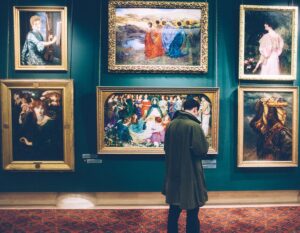As an artist or art collector, establishing the authenticity of your artwork or prints is crucial for building trust and ensuring the value of your pieces. A valid Certificate of Authenticity (CoA) serves as a tangible document that verifies the origin, genuineness, and provenance of the artwork. In this article, we will explore the essential steps and elements involved in creating a valid Certificate of Authenticity for artwork and prints, empowering you to provide confidence and transparency to buyers and collectors.
1. Include Detailed Artwork Information

According to Arttrust, a valid CoA should begin with detailed information about the artwork or print. Include the title, dimensions, medium, creation date, and a brief description of the piece. This information helps buyers and collectors understand the unique aspects and characteristics of the artwork, adding value to their purchase. For prints, specify the edition size and number, if applicable.
2. Artist Information and Signature
Next, provide comprehensive information about the artist. Include their full name, contact details, and a brief biography highlighting their accomplishments and artistic journey. This section authenticates the artwork by establishing the artist’s identity. Additionally, consider including the artist’s signature or a digital representation of it to further endorse the artwork’s authenticity.
3. Describe the Creation Process
Offer insight into the creation process of the artwork or print. Describe the techniques, materials, and tools used, showcasing the artist’s craftsmanship and expertise. This information adds depth to the CoA and assures buyers of the artwork’s genuine creation.
4. Provenance and History
Outline the artwork’s provenance and history of ownership. Document any significant exhibitions, galleries, or collectors who have previously owned the piece. Mention any notable achievements or awards the artwork has received. This establishes a chain of custody and enhances the artwork’s value and reputation. Include relevant documentation, such as receipts, invoices, or exhibition catalogs, to substantiate the artwork’s journey.
5. Include High-Quality Images
Integrate high-resolution images of the artwork or print within the CoA. Showcase the piece from different angles, capturing its details, textures, and colors. These images serve as visual references and provide evidence of the artwork’s unique characteristics, making it easier to identify and verify.
6. Security Features
Incorporate security features into the CoA to prevent forgery and protect its integrity. Utilize holograms, embossed seals, or tamper-evident stickers to authenticate the document. These features provide an additional layer of trust and deter counterfeiters, assuring buyers and collectors of the CoA’s validity.
7. Expert Verification
If possible, seek validation or endorsement from a recognized art expert or authority. Consulting an expert adds credibility to the CoA and boosts the buyer’s confidence in the artwork’s authenticity. An expert’s signature or endorsement on the CoA lends further weight to its validity.
8. Issuance and Registration
Clearly state the issuance date of the CoA and assign a unique identification number to each certificate. This number serves as a reference point for tracking the artwork’s provenance and authenticity. Maintain a comprehensive registry of CoA details, including the artwork’s title, artist, issuance date, and identification number.
9. Use Professional Printing and Archival Paper
Ensure that the CoA is professionally printed on high-quality, acid-free, archival paper. The use of such paper preserves the longevity and durability of the certificate, preventing degradation over time. Professional printing adds a polished and professional touch to the CoA.
10. Clear Language and Formatting
Write the CoA using clear and concise language that is easily understood by buyers and collectors. Avoid using
ambiguous or overly technical terms. Use a consistent formatting style throughout the document, employing headings, subheadings, and bullet points where necessary. This enhances readability and makes important information easily accessible.
11. Keep Copies and Digital Records
Maintain both physical and digital copies of the CoA for your records. Store the physical copies in a secure location, such as a safe or a fireproof box. Digitize the CoA and securely store it in multiple locations, such as cloud storage or encrypted external drives. Keeping copies ensures that you can provide duplicates if needed and helps to preserve the certificate’s authenticity over time.
12. Transparency in Sales
When selling artwork, openly communicate the availability of the CoA and emphasize its significance. Educate potential buyers about the benefits of owning a validated certificate, including increased confidence in the artwork’s authenticity and potential appreciation in value. Make the CoA a selling point and showcase it alongside the artwork to reinforce trust and transparency.
13. Update the CoA if Needed
In the event of any changes to the artwork’s ownership, exhibitions, or significant events, update the CoA accordingly. Maintain accurate records and ensure that the CoA reflects the artwork’s current status. This ensures the document’s accuracy and relevance over time.
14. Educate Buyers and Collectors

Take the initiative to educate buyers and collectors about the importance of a valid CoA and its role in the art market. Provide resources, such as brochures or online content, explaining the significance of proper authentication and documentation. Emphasize how a valid CoA adds value to their investment and fosters trust in the artwork’s authenticity.
15. Website Which Provide CoA Service
There are numerous websites that provide artists tools to help them manage their artwork including offering certificates of authenticity. While using a template is a great starting point sites such as ArtworkArchive offer a wide range of tools including, cataloging, invoices, inventory management and of course, artwork certificates.
Once you register and log in, you can easily follow the provided instructions.
Conclusion
Creating a valid Certificate of Authenticity for artwork and prints is essential for maintaining trust, ensuring value, and preserving the integrity of your artistic creations. By following the outlined steps and including the essential elements in the CoA, you can provide buyers and collectors with confidence in their purchases while safeguarding your artistic legacy. Embrace the power of a well-crafted CoA and elevate the authenticity and value of your artwork and prints in the art market.